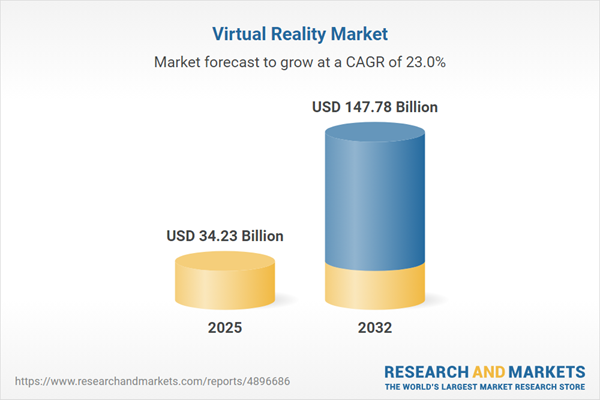Speak directly to the analyst to clarify any post sales queries you may have.
Virtual reality is redefining enterprise strategies, equipping organizations with transformative tools for workforce training, operational efficiency, and customer engagement. As the demand grows for immersive technology in business, executives seek authoritative insights to inform investment decisions and maintain a competitive edge in digital transformation initiatives.
Market Snapshot: Virtual Reality Market Growth and Outlook
The virtual reality market is on a robust growth trajectory, advancing from USD 28.23 billion in 2024 to USD 34.23 billion in 2025, and projected to reach USD 147.78 billion by 2032, reflecting a compound annual growth rate (CAGR) of 22.98%. Accelerated adoption across industries is being driven by technology innovation, operational integration, and expanding enterprise use cases. Business leaders are observing real productivity gains and service enhancements as VR is woven into core processes. This acceleration has prompted a rise in executive-level interest and substantial investment activity aimed at improving customer experience and future-proofing workforce skills worldwide.
Scope & Segmentation
- Technology Type: Fully-immersive, semi-immersive, and non-immersive solutions are deployed for simulation, advanced visualization, and interactive training across industry sectors, allowing organizations to match technological depth with their application needs.
- Component: Hardware offerings encompass head-mounted displays, input controllers, and motion sensors, while software is tailored to functions such as training modules, content creation, and enterprise development. Service providers deliver consulting, integration, and maintenance to streamline enterprise VR deployments.
- Device Type: Mobile, standalone, and tethered devices address varying performance and mobility requirements, ensuring that enterprises can adapt VR adoption to either user-driven experiences or mission-critical workflows.
- End User: Key industries utilizing VR include aerospace and defense for mission planning and training, automotive for design prototyping and operational processes, education for immersive learning, as well as healthcare for simulation, therapy, and rehabilitation. The technology is also used in gaming, entertainment, retail for virtual product displays, and by real estate and tourism for immersive tours that enhance decision-making.
- Geography: The market spans the Americas, Europe, Middle East & Africa, and Asia-Pacific. Notable countries include the United States, Canada, Brazil, Germany, UAE, South Africa, China, India, Japan, and Australia, with each region influenced by local infrastructure, regulatory frameworks, and investment climates.
- Leading Companies: Industry shaping organizations include Firsthand Technology Inc., Google LLC, HTC Global Services, Merge Labs Inc., Meta Platforms Inc., Microsoft Corporation, MindMaze Holding SA, Penumbra Inc., Samsung Electronics Co. Ltd., Sony Corporation, Ultraleap Limited, Dell Technologies Inc., Lenovo Group Limited, ASUSTeK COMPUTER INC., Apple Inc., LG Electronics Inc., Acer Inc., Unity Technologies, FOVE Inc., NVIDIA Corporation, Qualcomm Technologies Inc., Varjo Technologies Oy, Sandbox VR Inc., and Vuzix Corporation. Their technological advancements and collaborations expand enterprise adoption and diversify available solutions.
Key Takeaways: Strategic Insights for Virtual Reality Stakeholders
- Technological advances in sensory fidelity, device mobility, and AI-enabled content are expanding VR’s value across business and industrial use cases.
- Organizations in healthcare, manufacturing, and defense see measurable improvements in simulation precision, workforce adaptability, and operational performance through tailored VR integration.
- Collaboration among technology providers, business operators, and content developers yields sector-specific VR solutions that address strategic objectives and resource constraints.
- Regional VR adoption is influenced by factors such as digital infrastructure maturity, regulatory policies, and availability of investment, with Asia-Pacific and the Americas leading due to conducive business environments.
- Flexible procurement methods, including subscription-based approaches, help enterprises control costs, simplify scaling, and manage increasing complexity as VR deployments expand.
Tariff Impact: Navigating United States Trade Measures
Recent tariff changes in the United States have increased costs for critical VR components such as display panels and motion sensors. This shift drives manufacturers to optimize regional sourcing and adjust assembly strategies for greater supply chain stability. As compliance costs evolve, executive procurement strategies are under review, while simulation and service providers are refining pricing and logistics to accommodate changing input costs and ensure supply continuity.
Methodology & Data Sources
This market analysis combines primary interviews with engineers, software specialists, service providers, and enterprise users in leading VR sectors. Complementary research includes patent analysis, regulatory documentation, industry reports, and industry association perspectives to validate and enrich report findings.
Why This Report Matters
- Supports senior leaders with transparent market intelligence, presenting a clear overview of virtual reality dynamics, key challenges, and evolving business strategies.
- Delivers actionable segmentation and regional insights, enabling strategic planning for technology investments, market entry, and global business growth.
Conclusion
This report equips executive decision-makers with a robust foundation for assessing VR market opportunities. It ensures informed planning for innovation, operational optimization, and continued organizational advancement.
Additional Product Information:
- Purchase of this report includes 1 year online access with quarterly updates.
- This report can be updated on request. Please contact our Customer Experience team using the Ask a Question widget on our website.
Table of Contents
3. Executive Summary
4. Market Overview
7. Cumulative Impact of Artificial Intelligence 2025
Companies Mentioned
The companies profiled in this Virtual Reality market report include:- Firsthand Technology Inc.
- Google LLC
- HTC Global Services
- Merge Labs, Inc.
- Meta Platforms, Inc.
- Microsoft Corporation
- MindMaze Holding SA
- Penumbra, Inc.
- Samsung Electronics Co., Ltd.
- Sony Corporation
- Ultraleap Limited
- Dell Technologies, Inc.
- Lenovo Group Limited
- ASUSTeK COMPUTER INC.
- Apple Inc.
- LG Electronics Inc.
- Acer Inc.
- Unity Technologies
- FOVE, Inc.
- NVIDIA Corporation
- Qualcomm Technologies, Inc.
- Varjo Technologies Oy
- Sandbox VR, Inc.
- Vuzix Corporation
Table Information
| Report Attribute | Details |
|---|---|
| No. of Pages | 184 |
| Published | November 2025 |
| Forecast Period | 2025 - 2032 |
| Estimated Market Value ( USD | $ 34.23 Billion |
| Forecasted Market Value ( USD | $ 147.78 Billion |
| Compound Annual Growth Rate | 22.9% |
| Regions Covered | Global |
| No. of Companies Mentioned | 25 |









